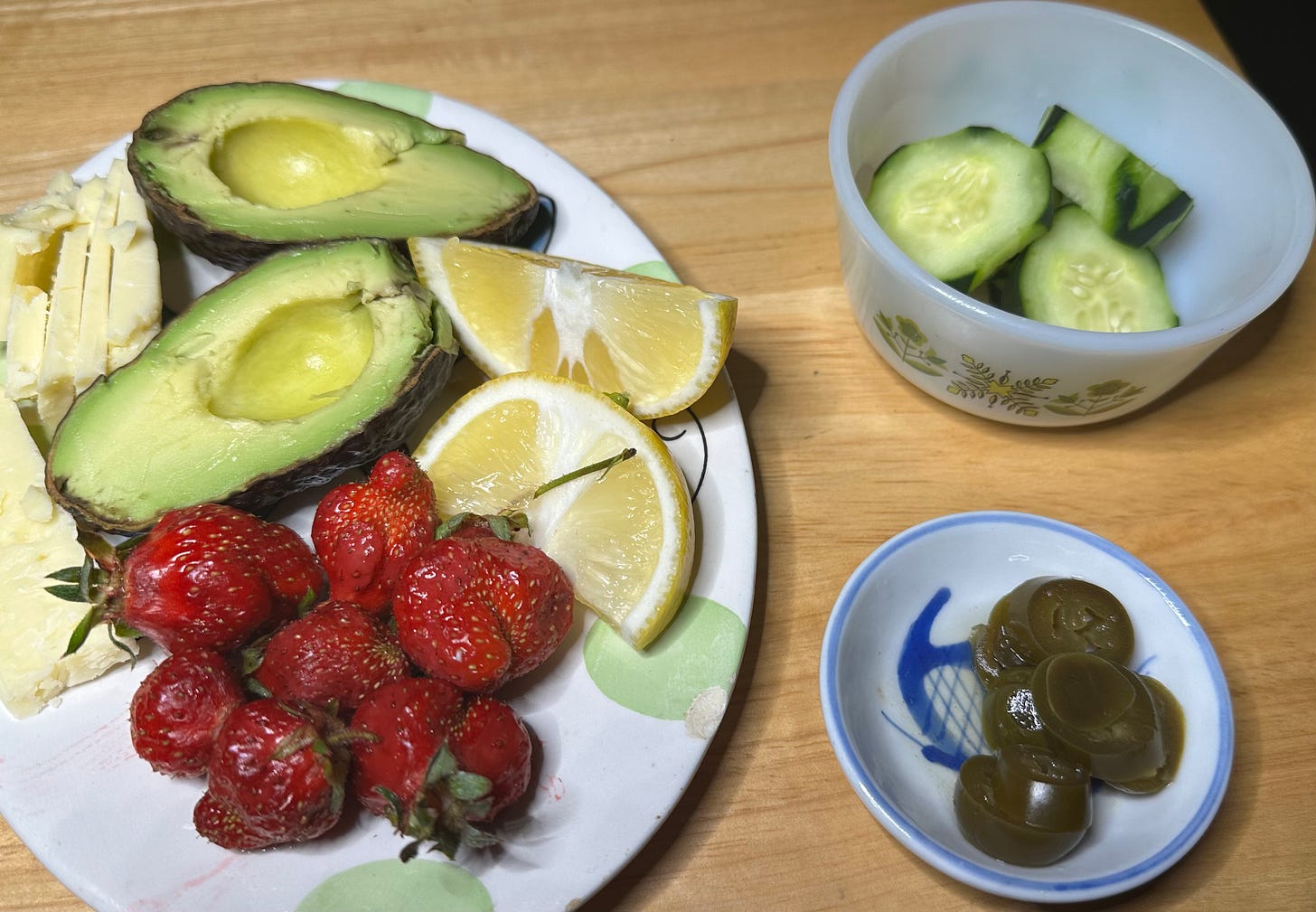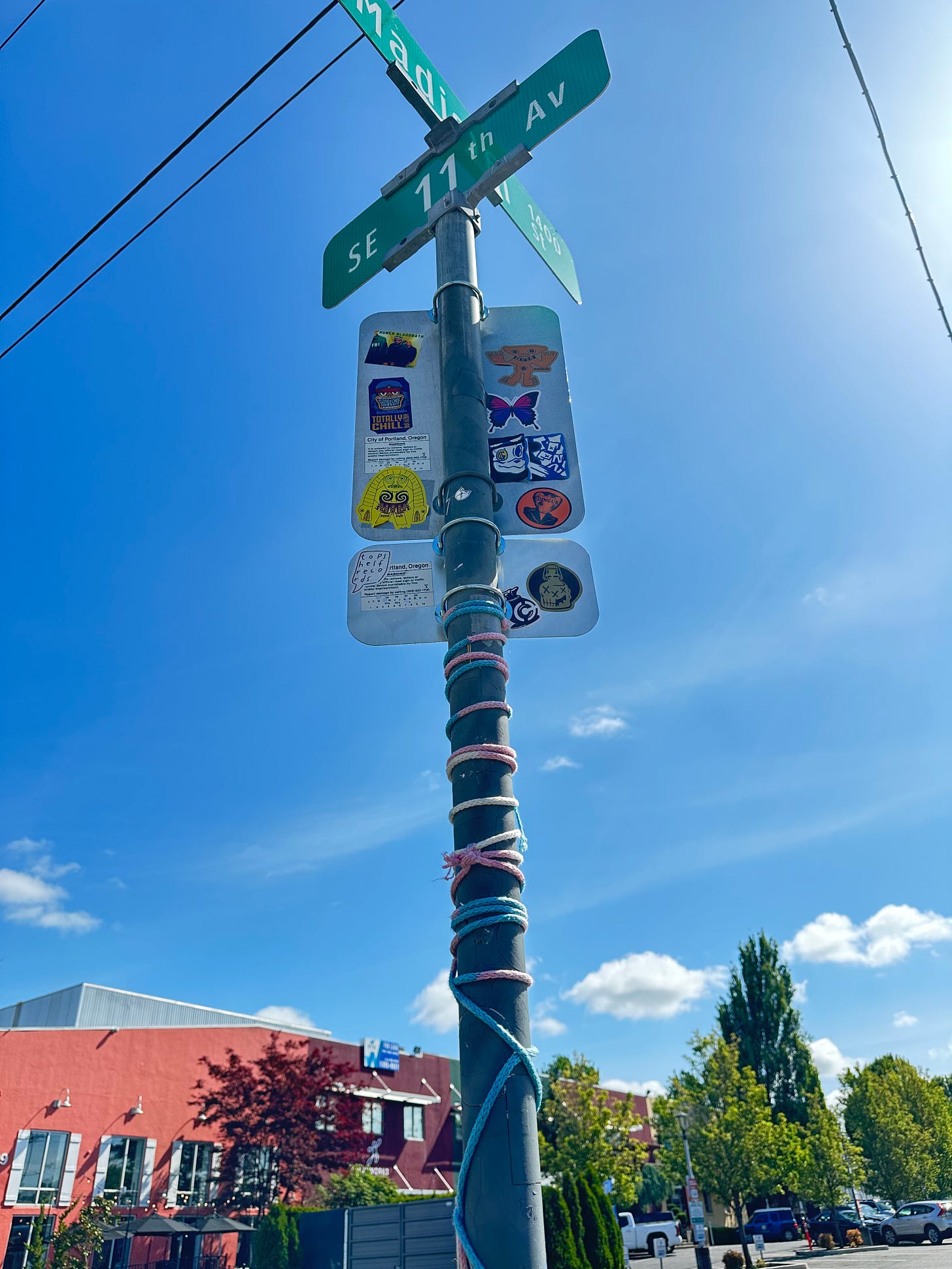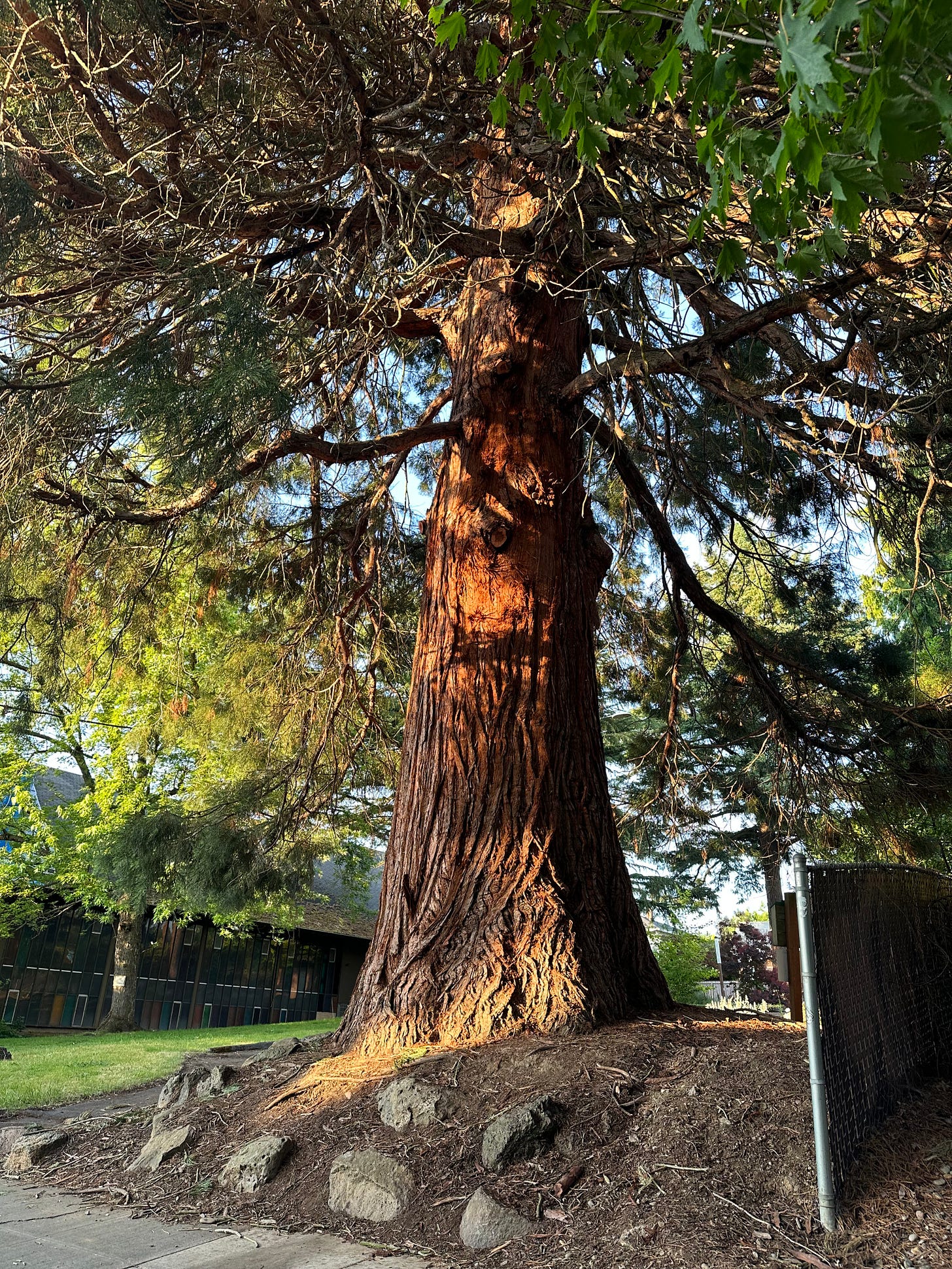Check in
Quintessentially Oregon
It’s strawberry season, which here in Western Oregon is brief and intense.
Oregon is famous for its Hood variety of strawberry. The plants have small, flavorful fruits that are very soft, perfect for making into strawberry jam, but too fragile to keep for more than mere hours. They are available at groceries where the produce managers are hep to the seasons and can work with the delicate berries. Hoods are only available for a few weeks in late May and early June.

Only two species of Fragaria, the genus that includes strawberries, are native to North America: wild strawberry (F. virginiana) and the alpine/woodland strawberry (F. vesca). These plants have tiny, delicious berries and make wonderful shade-loving ground covers. Let the kids discover the tiny, edible berries hidden amid the leaves.
Yarn bomb
National Yarn Bombing Day is June 11 this year. That’s a Wednesday.
Yarn bombing, wrapping objects in public spaces with knitted or crocheted art, has been a thing for about 15 years. On June 11, you may see decorations on trees, poles, doorknobs or statues. Here’s a small example of public knitting on a post at a bus stop at Southeast 11th and Madison.
Want to learn more? Check out Yarn Bombing: The Art of Crochet and Knit Graffiti, by Mandy Moore. You can find it at the Multnomah County Library.
Cake dreams
June 11 is also national German Chocolate Cake Day.
German chocolate cake is not German in origin. It contains German Chocolate, a sweet dark baking chocolate made by Baker’s and named for Samual German, the American baker who developed it 173 years ago.
Buttermilk makes German chocolate cake tender. The delicate chocolate flavor is a good palette for this cake’s signature coconut-pecan frosting, made with evaporated milk, butter, egg yolks and sugar.
Another cake on a German theme is Black Forest Cake. Dark chocolate sponge is soaked in Kirschwasser (cherry brandy), then layered with cherries and whipped cream. It’s topped with shaved chocolate.
From chocolate to toothpaste
For many years, the backyard of our house featured a 12-foot-high wall shielding us from the apartment house beyond it. The wall was a Shakespearean looking edifice, covered in lush Boston ivy. It could have come right out of A Midsummer Night’s Dream.
This wall was the last standing vestige of a carport-garage that had been torn down because over time it had become unstable. The owners didn’t want to spend the many thousands of dollars it would take to completely demolish it (I don’t blame them), so they elected to cut it down to a more manageable six feet.
The wall is still beautiful, still coated in ivy, and now we have a full view of the apartment building on the other side. I call it the Toothpaste Building.
Over the seasons, the Toothpaste Building has charmed me with its shifting color (depending on the time of day and time of year). I was also fascinated by its general aura of decay. This photo is of the west wall of the building, taken in early morning light during last February’s snow.
New life
A few weeks ago, activity started at the Toothpaste Building. Workers were prepping the outside for painting.
Soon, the building had a new color—still toothpaste, just a different shade. Perhaps mintier. The shutters on the front of the building were painted a fresh shade of orange.
Next, another set of workers appeared to replace the roof. Perhaps the reason for all this renovation is that the building will be sold.

Names
Maiden name
I recently encountered someone with the relatively unusual surname Pollak. That is my maiden name. I am née Frances Marie Pollak, named for my two grandmothers.
I used several terms in the previous paragraph that may not still be in common usage. No one says “surname”; it’s “last name” or possibly “family name.” “Maiden name” is also archaic. Perhaps “birth name.” And the referral to “née,” meaning “born” in French: other than as a crossword puzzle staple, does anyone ever use it? After all, “born” or “born as” work fine.
One of the great things about English is that it often has many terms for the same object. Instead of “first name,” I could write “given name” or even “Christian name,” meaning the one I was baptized with.
As for why I’m not still Frances Pollak, well, that has mostly to do with convenience. I married a man named Gardner in 1972 and was happy to change to Gardner from Pollak. The issue with Pollak wasn’t that it was ethnic but that it was hard for others to spell and pronounce. So often it was spelled Pollack or Pollock. The pronunciation is Pawl-uck, but people would usually say Pole-ack.
I was mildly unfortunate in having two names that are often misspelled. One reason I use Fran instead of Frances is that Frances can be missspelled with an “i”. Francis is the boy’s name, all right?
When I got divorced in the 80s, I decided to keep Gardner. I was known by that name at work, and this name was easy to say and spell, aside from the occasional glitch that spelled it Gardener. And I like the play on “gardener,” as I used to enjoy gardening before MS put the kibosh on that.
Next marriage
In 2004, I married Robert Jaffe. I could have taken his last name, but:
Women commonly don’t take their husbands’ names anymore. And certainly not the whole name as their identifier, like Mrs. Alvin Gotrocks. Folks, I am so old that I remember when the common way of referring to married women was with Mrs. and the man’s name.
Robert’s mother was also named Frances. She was such a character and such a force of nature that I wasn’t sure the world could handle two Fran Jaffes. And again, folks knew me professionally as Fran Gardner.
Spelled backwards, I am Narf Rendrag. Pretty, cool, right?
Keeping the surname
For a while in the 1970s, couples would combine their two last names with a hyphen, but that could get bulky and awkward. And when their kids got hitched, what would happen to the names?
I once knew a woman whose last name was Finipott. She and her partner were named Finnegan and Potter, and they just smashed together parts of their names.
Motivational name
I continue to be entranced with Mel Robbins, a woman I’ve followed from afar since her 1996 marriage was featured in The New York Times with a followup 10 years later. She was born Schneeberger and initially kept her maiden, er, birth name (the one she was née’d with). One of the places I wrote about her is here. Later, I noted that she’s written a best-seller called The Let Them Theory.
When Schneeberger moved from lawyering to motivational speaking, she found that Mel Robbins (using her husband’s last name) resonated better than Mel Schneeberger. You go, Mel. If anyone gives you a hard time about the name switcheroo, just Let Them.
Steven and Stephen. Or just Steve
A fellow coffee shop denizen who was admiring my portable keyboard said his name was Steve. Lots of Steves have crossed paths with me lately: the man who helped us choose our central air system, another man at a coffee shop who rescued me with a handful of napkins when my fountain pen leaked ink on my fingers. I recently interviewed an author, Steven Christiansen, who has found time around his job as a counselor at Estacada High School to write a wonderful teen book, The Blue Line Letters. This book uses a commute on the MAX Blue Line from home in Gresham to a job in faraway Hillsboro as a vehicle for telling stories and describing personalities and observations made from the train.
Spelling
The spelling Stephen has been around for a while. St. Stephen was the first Christian martyr. His death by stoning is described in the book of Acts. Steven is a later formation, probably to make the name easier to pronounce.
Either way, Stephen is one of those great names from the Greek. The original word is stephanos, στέφανος, meaning crown.
Some Stephens
Stephen Mitchell has written verse adaptations of classic Asian texts, like the Bhagavad Gita and Lao Tzu’s Tao Te Ching.
I don’t read much of Stephen King’s fiction because I’m afraid of horror, but his book On Writing is really good.
Leslie Stephens is the author of the popular “Morning Person” Substack. She lives in Portland.
I like Neal Stephenson’s writing. He writes “speculative” fiction, sort of like sci fi but better. The main character of Snow Crash (2000), Hiro Protagonist, lives in a shipping container that has great Internet connectivity. I seem to recall that pizza delivery is involved.
Poetic Irishman James Stephens published The Crock of Gold in 1912. I don’t think that I read all of it. But here is a quote from it that I once saved: “Curiosity will conquer fear even more than bravery will.”
Stephen Jay Gould, American paleontologist, wrote popular science books like The Mismeasure of Man. And then there is Stephen Hawking, the physicist who popularized time.
Other personalities: Stephen Rae and Stephen Fry, both fabulous actors. Stephen Sondheim, composer. Stephen Colbert, reconteur.
And Steves
Steve McQueen, actor
Steve Jobs, rich guy
Steve Martin, funny guy
Steve Wozniak, forgotten co-founder of Apple. Not such a rich guy because he didn’t retain his shares in the company.
Steve Allen, raconteur, worth a dozen Colberts. And Colbert is pretty good.
Girl Steves
Stephanie is the female version of Stephen. The only famous Stephanies who come to mind are the tennis player Steffi Graf and the singer Stevie Nix. Also the old-timey actress Stephanie Powers (she was briefly “The Girl from U.N.C.L.E.”), who is now 82.
Another famous “Stephanie” is Stefani Joanne Angelina Germanotta. She is Lady Gaga.
Pause for poetry
Unattainable
Low-hanging fruit, I still can’t reach it Books on a shelf lying out of my reach Ideas that flutter just beyond knowing Children who, laughing, run far away. Why can’t I capture the things that I yearn for? Why are they always just over the edge? Don’t think I’m not grateful for all that I have, But, oh! All those shiny things just past my grasp! The wine in the cup, the chalice turned over Far beyond anything, anywhere real. The surf turns to the ocean before I can fathom Which dead ideas I should cast on the waves. Strip things from me, let them float away onward. I can keep only the things that I need. Things will come to me, too, when they are needed. So I rest, semi-sated, yet ready for more.
Check out
Unicycles and sequoia
On the way to choir practice, I encounter a clutch of folks standing around with these odd transports I’ve been seeing lately—single wheels that you stand on both sides of. They are electric unicycles. Are they hard to balance on? I ask. No, say the group. There are about five of them, set to cycle off to a tavern for dinner.
They tell me that I just missed a big neighborhood event. A loud one. A crew was pruning the giant sequoia across the street, chipping the clippings with tremendous noise. This sequoia stands at the edge of the parking lot of a building that used to be Colonial Heights Presbyterian Church, but now is abandoned and empty, waiting for a buyer. It does look renewed and hopeful—the tree, that is, not the church.
Long, already
This week, I won’t take much space to sign out.
Just know that I appreciate comments. I like having subscribers. I like that hundreds of people read Becoming each week. Some of you—a lot of you, actually—even pay for the privilege, although you could read it for free.
Here’s the tip jar link at PayPal, where you can donate in increments of $5. Or hit the subscribe button to support me with a monthly or yearly donation.
Thank you.
Forever, Fran









Robin here, writing another fan note. My mother, a writer and anglophile named me, I've assumed, after Christopher Robin. Which really appeals to me. My mother's name was Biloine. Pronounced "Bill O'ween". But everyone called her Billie. We both grew up with gender neutral names. Which I always liked. I think Mom did too.
Thank you again. I sure enjoy walking around the neighborhood and becoming with you.
Hi Fran. It's Richard again.
This was really a fun writing by you.
Just a couple of comments:
I took an interest in all the major religions when I was in my twenties. I bought a large coffee table book entitled "The Five Great Religions of the World".
I read all of it and discovered that all the sects were beautiful before being slowly rewritten through the centuries.
The funny thing, I thought, was that they all started with the main characters riding in horse drawn vehicles fighting those who weren't of their faiths.
A most interesting read I had separately was the entire "Bhagavad Gita as it Is". Loved it.
Then, when I discovered Jainism, I determined it to be the most practical and nonintrusive of all the faiths.
...
Steves.
One of my good friends was named Stevem. I don't remember why his Steve ended with an "m", but there it is.
Thank you for another refreshing, relaxing read. You're the best.
Richard